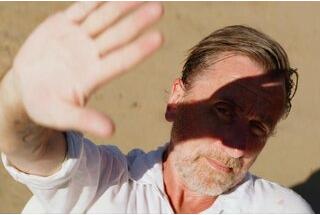Interview with Xavier Dolléans, AFC, about his work on two episodes of the series "Mrs. Davis"
By Jonathan Bensimhon, for the AFCHow did you come to work on this project ? What was its starting point ?
Xavier Dolléans : Episodes 1/2/6/7/8 of "Mrs. Davis" were shot in Los Angeles between March and August 2021. Shooting of episodes 3/4/5 was supposed to take place in Spain right after. I was put in contact with the production to shoot episodes 3 and 4. I was contacted on Wednesday, I had my interview on Friday, and the following Wednesday I was already in Spain for 10 weeks, including 5 weeks of preparation. I learnt to know director Alethea Jones as we did our scouting together. I also became familiar with the scale of the project and the means made available by the producers for this series that I knew would be ambitious, because Damon Lindeloff (known for "Lost", "Watchmen" and "The Leftovers") was its showrunner.

The series’ initial pitch is the following : a nun living in a remote convent has to fight an artificial intelligence named Mrs. Davis. Mrs. Davis will entrust her with a mythical quest : the Holy Grail. It is very difficult to talk any further about it without giving spoilers. The series constantly oscillates between science-fiction, drama, and comedy. Alongside its definitively modern take in questioning the presence of artificial intelligence in our lives, it also discusses the themes of religion and faith in an original way, which is unique to Lindeloff.
I was very quickly put in contact with Alethea Jones, the director of episodes 3 and 4. Alethea is a very talented and precise Australian director, she is highly visual. She pays a great deal of attention to the screenplay and to the actors’ performances. She is used to working on Hollywood TV productions and she guided me with a great deal of kindness during the first weeks of preparation, and she was always very attentive to my suggestions. We painstakingly broke down each sequence every weekend and during the weeks of shooting. It was an intense schedule of 12-hour days, 7 days a week, for several months.

In terms of artistic collaboration, what was most new to me was how closely I worked with the American showrunners. Every time I hesitated about how to interpret the screenplay or if we wanted to make modifications to it for reasons related to the sets, the shooting time, or scheduling, we had to submit our ideas and questions to the showrunners Tara Hernandez and Damon Lindeloff. We would also show them the photos of our sets, costumes and accessories. We had a lot of specific meetings and, in particular, one interesting meeting called "Tone Meeting" where we were to make sure we were all in agreement about the narrative tone we would give each sequence. IT was very interesting to see that, of course, we all had subtly different interpretations of the screenplay. The showrunners were extremely present and defended their ideas solidly against the studio. This dynamic was new for me and I think it was invaluably necessary when so many directors and cinematographers are working in parallel on the same project, which has to be narratively and visually coherent.

The series was produced by Warner Bros TV for its Peacock streaming service. After a week of preparation, I understood that we had significant means at our disposal : on many locations we scouted, the American production director would say : “No, not here, there’s not enough room for our base camp”. Later, I learnt that we had a budget of 10 million dollars per episode, meaning a global budget of around 100 million dollars for the 8-episode series. Going from Germinal to "Mrs. Davis" was an exercise full of many challenges and the first was to adapt my working habits to this new scale. Globally, it was a 2.5-3x difference in scale, and that applies to everything : the size of the crews, the time given for each sequence, and the size of the base camp !


What were the main challenges ? What were the challenges for you personally ?
XD : The challenges were many and the first was the scale of the work. Moreover, the script itself contained many artistic and technical challenges. Then, one of the major challenges was collaborating with the other cinematographers, especially Joe Anderson, who was the cinematographer for episodes 1/2/5/8 directed by Owen Harris. He had prepared a mood board full of cinematographic references going from Romeo and Juliette (1996) for the color, to No Country for Old Men for the framing. Joe had also prepared a 2.39 format widescreen mood board to show the artistic interest of shooting in that format with a single sentence on a black card that made me smile : “The average size of televisions sold in the United States last year was 55 inches. Audiences can therefore now fully enjoy a 4K HDR image and not feel they are seeing an image cut by black bands.”
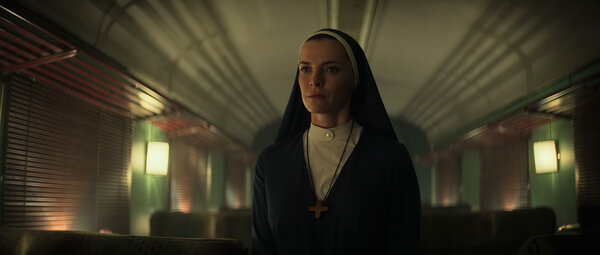
It is to be noted that in France, in 2021, the average size of a television was 46 inches, or 110 cm. I think that it would be important to communicate this statistic to our own decision makers, in order to reassure them, when we make this kind of decision.
I had access to all the dailies since the start of shooting as well as several already-edited episodes. This was very useful in understanding the tone, rhythm and look that had been initiated by the other crew. I asked Joe all the questions I could think of about what he had already shot, such as the mobility of the camera, his favorite type of shot, whether or not it was appropriate to flatter the beauty of the face of a given character, the contrast ratio, the t-stop he preferred in function of different situations, the filters, the size of the lighting installations on each sequence, how he worked with the camera operators, the number of shots per sequence and per day, the prep time, the work with the set design crew, etc.
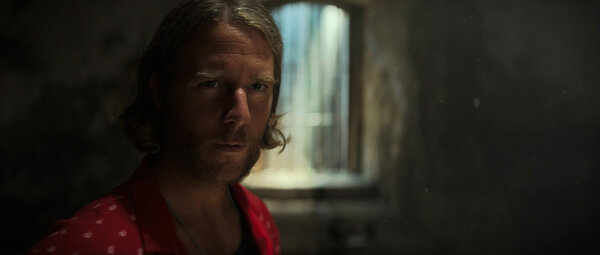
Joe had also created a LUT with high contrast and increased saturation on certain parts of the signal. Joe was shooting with director Owen Harris (Black Mirror) and I was shooting with director Alethea Jones (Rise of the Pink Ladies). In the end, the approach to shooting was rather different as Alethea liked to cover the action and the script with a lot of different types of shots to punctuate the screenplay in a very precise way.
How did you ensure continuity in the look across different crews ?
XD : I am often asked that question and it is interesting to observe how the look of a project can be transported from one crew to another crew, from one episode to another. When you have the same cast, the same set designer, the same costume designer, the same camera operators, the same lenses and the same LUT, and when everyone works well together, I think that a few shots, particularly exterior day shots, naturally begin to resemble one another even if they are made by different crews, at least enough to be part of the same series ! I think the process is very interesting because it allows us to deeply analyze what really makes the image. And especially, it allows us to contemplate what it is that we contribute as cinematographers : our taste, our way of shooting, of lighting, what will really serve the story, and what we might do differently from other teams, and especially why. It also helps us to put our cinematographer’s ego aside a little bit !



Paradoxically, each of us was very free to shoot and light as we pleased. Our singularities were even encouraged as they contribute to the visual and narrative richness. Once we, the members of the creative team, had been chosen by the producers and we were familiar with what had already been shot, we were given a great deal of trust. Whether it was the way Alethea Jones and I decided to block the sequence, or my choices of ambience or light direction or color for the night scenes… I was very free. After our initial discussions on the look, no one ever came and questioned my choices during shooting.
What were the technical choices on the series ?
XD : The cameras were Alexa LF and Mini LFs. For the lenses, Joe Anderson chose the Caldwell Chameleon S35+. It was an interesting choice for an unprecedented configuration : the camera was recording in Full Frame 4.5K and we were using the "S35+" lens circle to cover a roughly 4K surface on the sensor, so it wasn’t totally Full Frame. We had customized framelines we could load each time we changed the lens, and our assistants became used to this exercise over the course of weeks. For the rest, the basic configuration is : 2 dollys, 2 camera operators, 1 Steadicam, 1 Ronin always at the ready, and some material that was brought in from time to time, such as a Scorpio 45 crane and a Technoscope 22 crane that were used at the same time on the Excalibattle scene. I really liked the Techniscope 22 because it could be used by our grips without an extra technician and it allowed me to improvise a lot of movements on the spot, a light traveling, forwards/reverse push. The reset times were also extremely rapid.
For the image rendering, did you create a specific workflow ?
XD : The LUT was created by Joe during preproduction. It was then applied to the dailies. I had a DIT on set that I would use to make a few touch-ups, mainly in order to harmonize the different cameras, in CDL format. As the look was already very strong, I didn’t ask the DIT to perform overly-complex touch-ups so that I wouldn’t get lost. In the end, because of non-compatible color space reasons, the look had to be redone from the start when we began color timing. Joe Anderson recreated a very distinctive look in the ACES color space which was then restituted as closely as possible within the REC 709 color space. That’s the look that was applied to his episodes and to mine.
Where did you shoot ? Lots of scenes look like they were filmed on location. Did you use VFX ?
XD : As much as we could, we built everything in real life. Even the giant sword that you see in episode 3 was actually there in real life : a 12-meter-long sword ! We had shot in Spain : in Barcelona and Figueras. For everything else, VFX were used to prolong the sets and erase unwelcome elements.

Moreover, the budget for "erasures" was also for me. I realized this at a moment when my crew was laboriously moving several 360 SkyPanels that weren’t being used and were lying there, because otherwise they’d be seen within the frame of the camera two shots later. The production manager came to me and said : “Xavier, if you want, we can just erase that. I think it would speed things up.” Although at first he was a bit surprised, the VFX supervisor confirmed to me that a rather large budget (between $30,000-50,000 per episode) had been dedicated to the erasing of "accidents". I learnt to use this joker card throughout shooting. The principle was obviously not to abuse it. I used it to erase Source Fours that were hung from a ceiling in a prison, for cranes that could be seen in reflections, for cables that were too long to take down, and for visible cherry-picker arms.

What were the most difficult sequences to shoot ?
`
XD : The most difficult sequence to shoot was the Excalibattle (episode 3). This sequence required hundreds of extras, stunt doubles, a race involving 70 participants who were running several hundred meters, which had to be handed off between 6 cameras in different configurations : quad + stabilized head, Roning on Segway, Steadicam, Scorpio 45, Supertechno 22, shoulder, dolly, heavy lifter drone. It all had to be constantly on the ready to shoot… As regards the lighting, I used a lot of black 6x6 frames in Butterfly configuration. Something that was especially new for me was to constantly have a crew entirely dedicated to rigging (cherry pickers, hooks, frames). This was a Spanish crew used to American productions, and which, the rest of the time, would set up structures for concerts and other events. The grip crew was therefore freed from having to take care of security of shooting from high places and could concentrate on the part called "camera support". That was essentially important because our cameras were constantly in movement and were always mounted on rails, telescopic cranes, Ronins, quads, etc.

During one of our nights of shooting where we had to use many cherry pickers for rain and lighting, as well as lighting balloons, a storm arrived as we were doing pre-light. At 11 a.m., I got a call from production telling me it would be impossible for us to use the 70-meter-long construction crane we had been planning on using for the light box, it would be impossible to fly the balloons, and that all the cherry-pickers had to remain at a very low level so they would be protected by the outer walls and moat of the castle we were filming in.
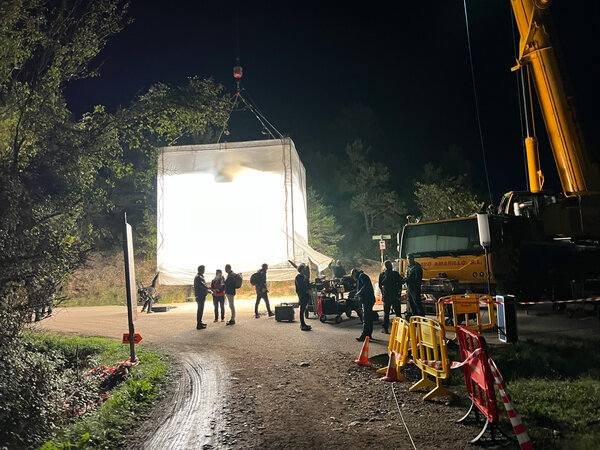
It was still early in the morning and no production driver was available. I called my gaffer and I made a drawing of a new lighting plan in the taxi that was bringing me to the set. My idea was to use the perimeter walls and to circle the set with 18K and 9K HMIs, attached at the bottom of their feet, from the top of the walls. Because of the wind, we couldn’t use any gels or diffusers. The 70-meter-tall crane and the lightbox remained grounded, because we couldn’t manage to move them within the time we had left for prelight. The balloons were deflated. Of course, all the spotlights were going to be within the frame around the fortress wall. My idea was that the spots could be scenic spots able to light the medieval cosplay nighttime event. Alethea was OK with that and was very helpful in making sure we were able to get all of the many pages of the script in with three cameras, at night and under the rain. The size of my lighting crew (around 25 people) allowed me to totally change my lighting philosophy so that I was able to shoot that night without problems. In the end, I think the result is very appropriate and I am quite proud of it. The HMI spots within the frame are constantly flaring and the fire on the ground creates a nice color contrast. All of the soft lights on the ground were made with SkyPanel 360s and Astera tubes. Our great flexibility faced with this storm was very appreciated by the American producers.
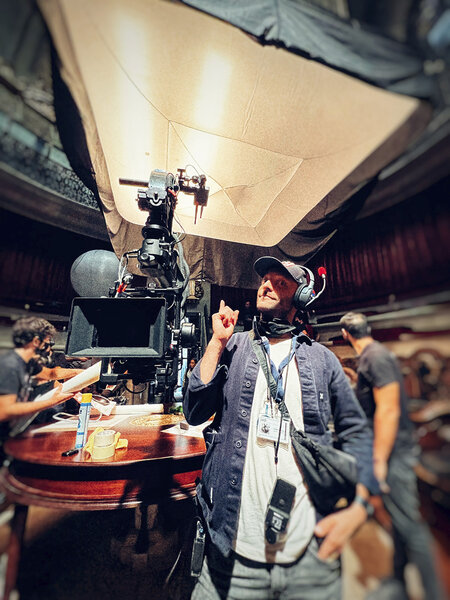
What have you taken away from this experience ?
XD : It really was a marvelous experience, and it was my opportunity to discover how American series are shot with a showrunner. I have come away from this very enriching experience with a lot of pleasure and a relationship to the work that is sometimes different from what we are used to in France. On projects of that scale, there is never the excuse that you don’t have the budget to do something. You are given the means, so there is an expectation of results that is very different. At the same time, in many ways things are also kept very light and there is an interesting ability to improvise, because the size of the crew, even though it can sometimes be gripped by a certain inertia, can also be very efficient if it is organized properly.
(Interview performed by screenwriter and director Jonathan Bensimhon for the AFC, and translated from French by A. Baron-Raiffe)
 En
En Fr
Fr


